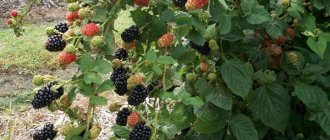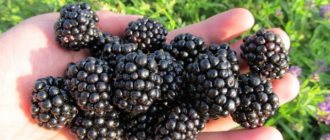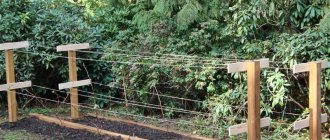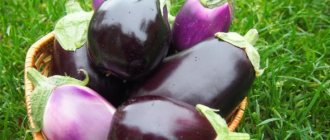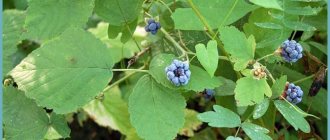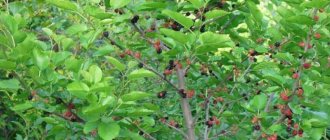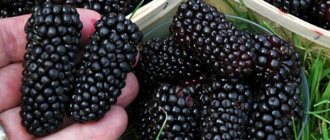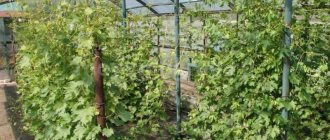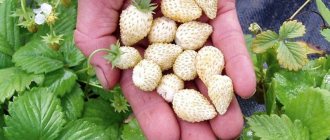What is remontant blackberry?
Remontant varieties of blackberries, just like similar varieties of its close relative, raspberries, are capable of bearing fruit twice a season. The berries of the first harvest ripen on shoots left over from last year, and the second harvest comes from shoots grown this year.
If desired, you can harvest one harvest from remontant varieties in the fall. In this case, the shoots are not left for the winter and the bushes must be completely cut off. Berries, accordingly, are set only on newly grown shoots. In this case, the fruits are large and there are more of them than in the case of double fruiting.
Blackberries are a heat-loving plant and in cool areas they definitely need to be covered in the fall. But even this does not save the shoots from freezing in frosty winters without snow. If we talk about remontant varieties, then they are not afraid of the cold - the shoots are cut out, and the rhizome is securely hidden underground. In the spring, new shoots will grow from the roots, which by the end of summer will bloom, form an ovary and bear fruit.
This is the kind of blackberry that is recommended to be grown in the Moscow region, where winter is unpredictable. Constructing shelters for large escapes takes a long time and requires corresponding costs for materials. In the case of remontant varieties, you can simply cut the bushes at the root for the winter.
Such blackberries are also good for mass cultivation in greenhouse farms in the middle zone. After all, getting two harvests, the first of which can be harvested under film at the end of April, is very profitable from the financial side.
Pruning blackberries in the spring of remontant species
Pruning is the simplest. All shoots that have grown over the summer are cut off at the root and covered for the winter. In spring, the bush will delight you with new, abundantly flowering branches.
Another way to prune blackberries in early spring. The method involves pruning young shoots to increase yield. Pinching rules:
- One-year young shoots are pruned by 10 cm only after they reach 1 meter. After pruning, lateral shoots begin to actively develop.
- After they form the main shoot, they are shortened by half a meter.
- By following these simple tips on how to properly prune blackberries in the spring, the plant will develop well, forming a luxurious bush, and will thank you with a rich harvest.
There is no bush in the garden more thorny than the blackberry. This is the main problem in crown formation. Properly thought out planting will help facilitate further care. For blackberries, as for raspberries, a plot is allocated that is separated from other plantings by a reliable box. Supports are placed along the edges of the structure; they are necessary for the construction of the trellis.
To ensure free access to each bush, maintain the required distance between the bushes. Upright varieties are planted at intervals of 3.5 m, creeping varieties - 4.5 m. This arrangement allows the shoots to be freely attached to the trellis, which greatly facilitates pruning and covering the bushes for the winter. Methods for forming blackberries are in the form of weaving, fan or rope.
What varieties of remontant blackberries are suitable for the Moscow region?
Advice. For the central region, it is advisable to select early-ripening remontant varieties, due to the fact that early frosts in the fall can partially or even completely destroy the crop.
There are not many varieties of remontant blackberries, and most of them are recommended for cultivation in the southern regions or in greenhouses. The varieties described below performed well in the cold middle zone.
Prime Jim (Prime Jim). Endowed with powerful, erect shoots strewn with thorns. Early variety. The first harvest can be harvested in early June, the second in August. Performed well in cool regions. Prime Jim is considered a variety that produces very high yields. The fruits are medium-sized (up to 10 g), elongated, sweet and sour. Unpretentious variety.
Prime Jan (Prime Jan). The earliest variety of its kind. The shoots of this blackberry are very strong, of medium length, and covered with thorns. Last year's branches begin to ripen in June, and this year's branches begin to ripen in August. The berries of the Prime Yang variety are large (up to 15 g), elongated, dense, with an apple aroma. They taste sweet.
Black Magic . Blackberry stems are powerful, of medium height, and there are significantly fewer thorns on them than on other remontans. Summer heat does not interfere with the formation of the ovary, which distinguishes this variety. The berries are shaped like an elongated cone. Small in size (7-8 g), sweet, with a pleasant blackberry aroma. Quite a lot of them ripen during the season.
Advice. Blackberries have a very poor shelf life - only 2-3 days, so before transportation it is better to cool them to low positive temperatures and place them in cardboard containers.
The best varieties
Breeders have developed more than 60 varieties of remontant blackberries. The following varieties have become the most famous and popular: Prime, Ruben, Giant, Black Magic. A brief description of each is presented below.
Prime
The most popular thornless variety. When ripe, the berry becomes almost black in color. Externally, the bush is very compact, the shoots grow vertically.
It bears fruit for 3 months - from August to October.
Ruben
The plant has a strong root system, grows on almost any soil, and withstands dry summers.
The height of the bush is 1.75 meters. It has a very decorative appearance, which throughout the season pleases with an abundance of flowers, and later berries.
For reference! The Ruben blackberry bush will produce its first harvest the next year after planting.
Giant
A frost-resistant representative of the remontant blackberry, it tolerates even the most severe frosts. The berries are large, reaching 20 grams.
The developed variety contains a huge amount of useful microelements: calcium, iron, sulfur.
Remontant blackberry harvest
How to grow remontant blackberries in the Moscow region
- Planting seedlings. Blackberries should be planted in the regions of the middle zone in the spring. If the soil is heavy, then you must first take care of drainage. The seedlings are placed in 40x40 holes and covered with soil. The plantings are lightly trampled and watered. It is advisable to immediately install trellises, since the shoots of the plant are very tall.
- Caring for remontant blackberries. This plant is not picky, so care comes down to watering and periodically loosening the soil. You can fertilize the soil for remontant blackberries with organic and complex mineral fertilizers. It is enough to do this when planting seedlings, and then once every few years. Winter pruning depends on your harvest plans. If the berries are collected twice a season, then shoots 1-1.5 m high are left for the winter, and if once, they are completely removed. In the spring, before the buds begin to bloom, the frozen shoots are removed, and the tops of the remaining ones are pinched.
- Shelter for the winter. It is recommended to build a shelter for blackberries in late autumn, when the temperature begins to constantly remain below freezing. The material for the shelter should be selected that allows air to pass through, for example agrofibre. Otherwise, during the winter thaw, moisture will begin to accumulate under the shelter, which, when the temperature drops, will cause the buds to freeze or damp out. The soil under an airtight shelter can also become very wet, which will lead to the death of the roots.
Some gardeners are inclined to believe that it does not make sense to get two harvests per season in the Moscow region. It is much easier to harvest a bountiful late harvest and cut off all the shoots at the root. However, it is impossible to give an unambiguous recommendation on how to deal with a fairly new crop in our latitudes. This is a personal matter for each amateur.
How to grow thornless blackberries in the Moscow region
To grow blackberries in the Moscow region, you need to take into account a number of factors:
- Choose and prepare the right place.
- Purchase planting material.
- Plant according to the characteristics of the variety.
For a timely and high-quality harvest, blackberry planting requires sunlight. When choosing a location, it is worth taking this cultural feature into account. Also, the bushes should not be blown by northern winds. The site cannot be located in lowlands where water stagnates; this will lead to rotting of the roots, and the plant will die over time. The soil must be fertile, with neutral acidity. The groundwater level should be low enough, at least 1.5 m from the surface.
To begin with, weeds are removed from the site, the soil is dug deeply, and the rhizomes of perennial plants are removed. Then the soil must be fertilized. To do this, add 10 kg of humus, peat or compost, 100 g of superphosphate, 30–40 g of ash or potassium salt for each square meter. All this is buried in the ground. It is recommended to prepare the site a year before planting. If this is not possible, then at least 2-3 weeks before the start of disembarkation.
As for planting material, it must be purchased from specialized nurseries; such a purchase will ensure the quality of the seedlings. Before purchasing, the plant must be thoroughly inspected. The shoots should be flexible and the buds should not be swollen. The root system of a suitable seedling is well developed, the roots are moist and not dry. There should be 2 shoots, their thickness should be at least 5 cm. A bud should be formed at the base.
Planting time for seedlings with an open root system is early spring. For seedlings in containers, at any time of the season. It is worth noting that the planting scheme for brambles and dewberries is different, so this factor must be taken into account when choosing a variety. Upright varieties require less space. Thus, the distance between bushes is maintained at 100–150 cm, between rows - 200 cm. For dewberry, 250–300 cm are spaced between bushes, and at least 300 cm between rows.
So, everything is ready, you can plant blackberries. This is done as follows:
- Dig holes measuring 50x50 cm. The distance is chosen according to the variety and type of plant.
- The soil dug from the holes is mixed with humus, superphosphate and ash, in the same amount as when fertilizing the site.
- Earth and additives are poured into each hole, filling them halfway.
- Then they are watered with water.
- After absorbing the liquid, the seedling is placed in the center of the planting hole; the roots need to be well straightened.
- Next, pour a layer of planting mixture, shake the plant slightly so that the mixture is evenly distributed between the roots, and cover it with a fertile layer of soil. Then you need to compact the soil well.
- The root collar should be underground at a depth of 5–7 cm.
- At the end of planting, a circle around the trunk is made, and the bushes are watered with cold water.
- After absorption, the tree trunk circle is mulched - a 5 cm thick layer of sawdust, peat, straw, etc. is poured.
- Seedlings need to be trimmed, leaving 1/3 of the length.
- The last stage is spraying the planting with a 1% solution of Bordeaux mixture.
At first, the seedlings need to be watered regularly. After rooting, proceed to standard watering once a week. In rainy weather, additional watering is not needed. Particular attention should be paid to shrubs during fruit setting and ripening. Lack of moisture during this period will have a bad effect on the taste and quantity of berries. In summer, the ground under the bushes must be loosened and weeds removed. A mulch layer will make maintenance easier.
Blackberry plantings are not too demanding to care for. They need to be fed on time, preventive treatments against pests and diseases must be carried out, and branches must be pruned in a timely manner. And blackberry bushes also need support. All this is not difficult to do if you know how to do it correctly.
The most optimal method for support is a trellis. To do this, you need to drive two-meter posts or strong iron pipes along the length of the row, and pull wire on them in three rows. The lowest row is at a height of 50 cm, the last one is at a height of 170–180 cm. Shoots are attached to the wire, this makes caring for the plant and harvesting easier.
Fertilizing is carried out at least twice a year - in spring and autumn. Nitrogen complexes are used for spring fertilizers, and mineral additives for autumn.
An important factor for a healthy plant is its pruning . It is also carried out in the spring, before the plant awakens, and in the fall, after harvesting. Spring pruning is preventive. Cut off branches damaged during the winter and dry ones. In the fall, the bush is carefully pruned and shaped. All fruit-bearing shoots are cut off; there is no point in them, since the next harvest will be on the shoots of the current year. Remove dry, crooked and weak branches. Young and thin branches also do not need to be left. Pruning is carried out at the root, excluding leaving stumps, as they will rot and harm the health of the bush. After pruning, the bushes are sprayed with Bordeaux mixture.
In the conditions of the Moscow region, almost all blackberries need shelter. To do this, immediately after harvesting and pruning the bushes, the branches must be carefully removed from the support, it is advisable to place something under them at the base, this will protect the shoots from breaking under the weight of the shelter. Cover before the onset of frost. Any covering material is suitable for this purpose, the main thing is that the plant under it can breathe.
But before winter, bushes need more than just shelter. It needs to be prepared.
They do this as follows:
- First, the bushes are pruned.
- Then all plant debris is removed from the site - branches, leaves, berries, grass and most importantly - the old layer of mulch. You shouldn’t send them to the compost pit; it’s better to burn it all off-site.
- Then the soil under the bush is loosened and, if necessary, a complex of fertilizers is applied. Water the plants well, apply a new layer of mulch, only thicker, at least 10 cm.
- Preventive spraying is carried out, which completes the preparation of blackberries for winter.
Garden blackberries propagate in several ways:
- green cuttings;
- basal offspring;
- dividing the uterine bush.
These are the most popular methods among professional gardeners. They are free, safe (the possibility of planting being infected by damaged material is excluded), and 100% safety of the variety is guaranteed.
Learn how to grow blackberries from seeds at home.
Description of propagation by green cuttings:
- The most productive bush is selected and the tops are cut off from its shoots. The branch remaining on the bush must have at least two buds.
- Cut branches are cut - divided into parts, each of them should consist of a leaf, a bud and part of a shoot.
- The lower parts of the cuttings should be immersed in a growth stimulating solution for 5–6 hours.
- While the plants are standing in the solution, prepare the planting mixture and containers. For the mixture, sand and peat are mixed at a rate of 50×50. As containers, you can use paper or plastic cups, as well as film envelopes. The cups have holes in the bottom.
- The seedlings are placed in containers filled with the mixture and sent under film.
- The greenhouse should have 100% air humidity and an average temperature of +22...+23°C. The soil also needs to be watered, maintaining 80% humidity.
- After 35–40 days, the seedlings can be transplanted to a permanent location.
Propagation of blackberries using root shoots. For this method, at the end of spring, green root shoots about 10–15 cm high are dug up from promising bushes and transplanted to a new location.
When transplanting a bush to a new place, you can propagate blackberries by dividing it. It is necessary to dig up a bush, carefully separate young strong shoots with good roots and plant them in a prepared place. The mother bush should have strong young branches on all sides. Weak and dry ones should be removed.
Important! The safest remedy for preventing diseases and pests is boiling water. In early spring, spray the stems and soil under the bushes with a watering can.
What is the difference between remontant blackberries and regular ones?
Blackberry, or ozhina, is a fruit subshrub that is only gaining popularity in Russian areas. Its shoots are fragile and break off easily. Almost all varieties require shelter for the winter, with the exception of plants growing in the southern regions. Conventional blackberry varieties have a two-year development cycle: in the first year, fruit buds are formed on the shoots, in the second year the bush bears fruit. Then the branches are cut out and everything starts all over again.
Read also: The best varieties of cherries for the Moscow region
Remontant blackberries are those that consistently produce two harvests per season. The primary ripening period is mid-June, the second is early autumn. The first harvest grows on last year's shoots, the second - on young shoots. Remontant blackberries can be grown like regular ones, cutting off last year's shoots for the winter and getting one harvest per season. Then the collection shifts to August-October. When the bush is completely pruned, the autumn berries are larger and sweeter, and there are much more of them on the shoots.
Caring for blackberries after pruning
Caring for blackberry bushes after pruning includes standard procedures: watering, weeding, fertilizing and preventive treatment against pests and diseases.
First, we remove all plant waste and weed the soil to remove weeds and remnants of young growth. Then we loosen the soil shallowly and apply phosphorus and potassium fertilizers. You should not use substances containing nitrogen - they provoke increased shoot growth, which is completely unnecessary before winter.
If the autumn is dry, moisture-charging watering will be required - 2-3 buckets of water for each bush. Please note: this must be done before applying fertilizer!
If during the season the bush has not been sick or suffered from insect pests, before wintering it is enough to treat it with a 1% solution of Bordeaux mixture. But in the presence of serious lesions, stronger fungicides and insecticides are required.
A couple of days after the preventive treatment, the blackberries can be covered for the winter.
Advantages and disadvantages of remontant varieties
To make the right choice, it is recommended to take into account the advantages of this type:
The harvest can be harvested already in the first year of planting. If the seedling was sent into the ground in the spring, the berries will ripen by August.
Varieties for the Moscow region and beyond
In order not to be left without preparations for the winter, it is preferable to grow not only blackberries, but also other fruit bushes. For example, if you prepare raspberry jam according to a five-minute recipe, then during the cold season you will have a reliable home remedy at hand.
Video about the formation of remontant bushes.
Blackberry remontant varieties with thorns
The cultivation of the following traditional varieties in the Moscow region is considered the most successful:
- Ruben is a bush up to 2 m high, covered with thorns. This is an early ripening blackberry; the first harvest from last year's shoots is harvested in mid-June. In early August, the ovaries ripen on young shoots. The bush does not require staking, grows successfully on any soil, and is relatively resistant to drought. Gardeners note poor fruit set during long dry periods. The berries are large, weighing up to 15 g. Their taste is sweet, practically without sourness.
In addition to the listed varieties, in summer cottages you can find Prime Ark 45, which is drought-resistant and has strong immunity to disease.
Video review of the Black Magic variety.
Thornless remontant varieties - the best varieties for growing
For cultivation in the Moscow region and the middle zone, it is worth recommending several varieties:
Pruning thornless blackberries in spring
To make caring for the crop easier, many summer residents prefer to grow special thornless varieties of blackberries. As the name suggests, the main feature of the culture is the absence of thorns on the shoots. This greatly facilitates the care of the crop, but there are other features that should be taken into account when growing this crop.
Firstly, seedlings should be placed at a distance of 2.5-3.5 meters from each other. Secondly, the trellises for the garter are pulled no lower than 2 meters from the ground surface. In addition, it is important to consider that thornless varieties are very responsive to fertilizing, which should be applied in early spring and during the formation of ovaries. Otherwise, caring for thornless blackberries, including pruning, remains the same as when growing traditional varieties with thorns
We recommend reading these articles:
Planting verbena seeds for seedlings in 2021
Pruning pears in spring for beginners in pictures step by step
Pruning grapes in spring for beginners in pictures step by step
Features of growing in the Moscow region
Experienced gardeners in most cases recommend achieving one fruiting of a remontant variety per season in favor of good yield. The climate of the middle zone does not allow getting a large number of berries in the autumn. Due to lack of heat and light, blackberries ripen small. Most often in the southern regions, a bountiful harvest is harvested from the bush twice a year, although there are exceptions.
If you adapt the bushes to the climate of the Moscow region, you can get one harvest per season, but it will be plentiful and tasty. The berries grow larger in autumn. If you want to enjoy black tart fruits more often than once a year, it is more advisable to plant remontant blackberries in a greenhouse.
Before planting, you need to choose the right seedling:
- The root system should be powerful and fibrous. The roots are of different sizes, moist and flexible, without signs of rot.
- The cuttings must have viable buds.
- The seedling is 1-2 years old.
To achieve active growth and fruiting on a site in the Moscow region, you will need to follow several rules:
The choice in favor of modern breeding achievements is fully justified if all the rules of care are observed, starting from the planting site and ending with the application of fertilizers. The main task of the gardener is to prevent the shoots from drying out and freezing.
Features of planting and care
To obtain regular harvests, it is recommended to follow the rules for planting and caring for blackberries.
Soil requirements
Blackberries prefer slightly acidified, medium-nutrient soil. It grows well on medium loams and sandy loams. Heavy loams should be sanded. It is recommended to acidify sandy soils with peat.
Blackberries love organics. Before planting, mature compost or humus should be added to the soil. It is important to avoid high groundwater levels in areas where shrubs are located.
Disembarkation dates and schemes
Remontant blackberries are planted twice a year: in spring (April-May) and autumn (September-October). Spring planting has the advantage: the seedling will have time to build up its root system and successfully overwinter.
When planting in the fall, the gardener runs the risk of getting a frozen bush in the spring. When planting later, the plant should be carefully covered and the soil should be moistened.
The shrub loves sunlight. This should be taken into account when placing bushes. Plants with a powerful habit are placed at a distance of 70-90 cm from each other. Compact plants allow planting every 40-50 cm.
Optimal climatic conditions
The plant is a native of the southern regions. Therefore, it grows and bears fruit best in regions with mild winters and long, warm summers. At the same time, the plant is sensitive to the number of sunny days. But breeders create frost-resistant varieties and hybrids with a short ripening period. If you follow the rules of care and select the type correctly, you can get two bountiful harvests even in problem regions.
Top dressing
Blackberries are responsive to the addition of organic matter. When planting, it is recommended to fill the planting hole with compost or humus. During the season, it is recommended to sprinkle compost mixed with mulch under the bushes 2-3 times. In autumn, phosphorus-potassium fertilizers in the amount of 20 g are required for each plant. After application, it is recommended to loosen the soil and cover it with mulch.
After the snow melts, it is necessary to feed the bushes with nitrogen fertilizers (urea). 10-12 g should be added to each plant. Then it is recommended to rake away the old mulch and cover the tree trunk space with new one. The layer should be 15-20 cm thick.
Trimming
After the plant leaves winter, it is recommended to carry out sanitary pruning. All frozen, broken shoots must be removed. Then in the summer 2-3 pinchings are carried out: the lateral fruiting shoots are shortened at a height of the main one of 30 cm and 70 cm. In the autumn, all shoots (old and new) are shortened to the size that the gardener can cover . If you plan to get one harvest, old shoots are cut out at ground level.
Diseases and pests: ways to combat them
Due to the way they are grown, remontant blackberries are practically not affected by the raspberry beetle and raspberry fly. But in dry summers the plant is threatened by spider mites. To prevent damage to plantings, it is recommended to monitor soil moisture.
Plantings are sometimes affected by anthracnose. To prevent disease, it is recommended to fertilize in a timely manner.
Selecting the best varieties of remontant blackberries: characteristics + photos
In this article I want to talk about news that can please any gardener. Breeders have managed to develop new varieties of remontant blackberries, which are gaining more and more popularity in gardening.
After all, the plant has a lot of different advantages, including frost resistance and the ability to bear fruit twice a season. At first, the berries ripen on old shoots, and in the fall - on young shoots.
Bush blackberry varieties
Bush blackberries have tough, poorly bending shoots. Their height rarely exceeds 2-2.5 m. There are usually 3-5 shoots in one bush. This is enough to get a harvest. Excess stems weaken the plant.
creeping blackberry
This type of blackberry has thin shoots that bend easily. Their length reaches 5-6 m. The tops easily take root on their own. Over time, such blackberries turn the area into impenetrable thickets. Rarely found in country gardens.
general description
Breeding remontant blackberry varieties is becoming increasingly popular. They are distinguished by their ability to produce crops twice during the growing season, if weather conditions permit. The shrub is unpretentious and does not require special care. The first fruiting usually occurs in early summer, and the second time the berries begin to ripen in September.
Using an annual cycle, cutting off old stems for the winter, berries begin to appear only on young branches, starting in August.
The care and flowering period, as well as the ripening of berries, are similar for all remontant blackberry varieties. The differences relate to varietal forms and organoleptic characteristics of the fruit.
There are types of remontant blackberries with and without thorns.
Plants with thorns are quite compact, with shoots growing upward. During flowering, the bush is abundantly covered with a cap of fragrant flowers, becoming like a lush bouquet. The bush blooms for a very long time, even when some of the berries are already ripe, flowering still continues.
The fruits are quite large and juicy, with a wonderful aroma.
Using an annual development cycle, with the onset of cold weather, all ground branches are cut off, protecting only the roots of the bush from freezing. There are many advantages to using the plant this way.
There is no need to fight rodents in winter; the plant is not afraid of spring frosts. In addition, there is no need for annual treatments with chemicals, and the fruits will be environmentally friendly.
Remontant varieties are distinguished by their ability to bear fruit in the first year after planting. And if you do not carry out complete autumn pruning, then such bushes bear fruit twice a season. Bushes of remontant varieties also have some external differences: the bushes grow more compactly, having long and abundant flowering.
Repairers
The bushes grow compact, but during the period of fruit ripening they require tying. The peculiarity of this variety is that it is harvested twice per season. The first is in early summer from old shoots, and new bushes produce berries in the fall. If the shoots are cut off at the root in the fall, the varieties will bear fruit only once at the beginning of autumn.
Ruben
Belongs to the most famous and popular variety. Grows up to 2 meters. The berries are large and heavy. Weight 14 grams. Resistant to frost and disease. There is no need to tie.
Black Magic
The variety is not very resistant to cold, so it is either bent to the soil or completely cut off before frost. Tied to trellises. Gives a good harvest.
Prime Ark-45
Grows up to 2 meters. There are many thorns on the straight, strong shoots. The fruits are elongated, sweet and dense. It bears fruit in early summer, and then a second time - from August until frost.
Prime Jim
The shoots are thorny, erect and strong. Fruits with a sweet and sour taste are elongated and large.
Prime Yang
This erect plant grows to medium height. Sweet fruits are endowed with a pleasant apple aroma. Refers to the earliest variety of all remontant varieties.
Prime Arc Freedom
Peculiarities:
- grows without thorns;
- the variety is unpretentious;
- has good taste;
- the fruits are large in size and well transportable;
- when covered for the winter, they are capable of bearing fruit twice next season.
See also
How to properly plant, grow and care for blackberries in open groundRead
Varieties of remontant blackberries
The most popular varieties among gardeners are:
It is one of the most productive varieties, selected in 2005 in the States. Excellent organoleptic characteristics and excellent yields have made this variety mega popular not only in America, but also in our country. The Ruben bush is large, growing up to two meters in height.
The branches are strong, capable of growing without additional help or support. The branches are covered with thorns. Ripening occurs in early summer. The fruits are quite large in shape and pleasant to the taste. They do not lose their shape during transportation.
Prime Arc 45
Also bred by American breeders. It has excellent taste characteristics, large fruits and early ripening. The bush is powerful and tall, with thorny branches. Practically not susceptible to various diseases. The only drawback, perhaps, is its poor resistance to winter temperature drops.
Prime Arc Freedom
This variety is distinguished by the absence of thorns - an achievement of American breeders. The fruits have excellent characteristics. They have a dense shell, which allows them to be transported even over long distances. The bush has a compact shape, with powerful branches that grow vertically.
Black Magic
The variety is distinguished by early fruit ripening and high yields. One bush produces more than five kilograms of beautiful berries per season. It has very few thorny thorns on the branches and is resistant to drought conditions. The berries are not afraid of the vagaries of the weather; the yields are consistently high no matter the vagaries of the weather. The berry size is average - up to 6-8 grams.
Another American variety from Arkansas. Its bushes are powerful, with shoots covered entirely with thorns, strong, not needing support, medium high. The fruits are large - 10-15 grams, with a pleasant aroma, somewhat reminiscent of apple.
It has a wonderful, sweet taste. The berries are dense and tolerate transportation well. The variety is frost-resistant. Fruits in two stages: at the beginning of summer and at the end.
Prime Jim
A completely new variety. It looks like a compact bush, the branches are straight, tall, with thorns. The berries are medium-sized, elongated, weighing approximately 10 grams. The taste is sweet, with subtle sourness. Well adapted to the conditions of the Moscow region climate.
This variety has no thorns, the shoots are long and flexible, growing up to two and a half meters. The flowering is long-lasting, spanning the entire summer period, the flowers are fragrant, 3 centimeters in size. The fruits begin to ripen in July.
Fruiting ends by October. During this time, it is quite possible to collect 30-35 kilograms of delicious fruits from each plant. The berries are very large and aromatic, weighing up to 20 grams.
The bush grows well and bears fruit in sunny areas with light, breathable soils. It is very frost-resistant; temperatures down to -30 degrees do not harm this giant.
Prime-Ark Freedom
A very attractive variety that produces a rich harvest of large fruits weighing up to 20 grams. The bushes are tall, up to two meters, with powerful, erect branches. Disadvantages include poor winter hardiness. It must be well covered for the winter.
But if the branches of the bush are properly covered, bent to the ground, then it is quite possible to get a harvest of berries from them by the end of June. And by the beginning of September, the second wave of fruits will delight gardeners with their excellent taste.
The berries will ripen until the cold days begin. If you prune the bush before winter, the berries will ripen on young shoots once a summer, somewhat later, but the harvest will be more abundant.
Prime-Ark Traveler
It has no thorns, and the fruits are small, weighing up to 8 grams, and taste sweet, with a slight sourness. Although this variety is not super-yielding, the berries are very shelf-stable and can be preserved for a long time. The ripening of berries begins quite late - towards the end of summer.
At high temperatures exceeding +32 degrees, ovaries on flowers may not form. It does not tolerate low temperatures in winter very well; careful shelter from frost and wind is required.
A completely new variety, bred by breeders only in 2021. Has excellent organoleptic characteristics. It has a pleasant aroma and a bright, sweet taste, almost without the presence of acid.
Black Jam bears fruit abundantly, yielding up to 15 kilograms of berries per bush. At the same time, the fruits ripen almost until frost.
Black Cascade
This variety seems to be specially bred for gardeners deprived of large plots of land. Black Cascade feels great in a small pot, among balcony flowers, decorating any adjacent space with a cascade of flowers and berries, without requiring a lot of space and care.
With the onset of autumn days, the leaves on the bush acquire a purple color, which makes it even more attractive. The bush blooms in July, and the first fruits ripen by early September, and fruiting continues until October.
The most productive varieties of blackberries
Every year new varieties of blackberries appear. But many gardeners - conservative by nature - are not even aware of the successes of breeders, continuing to grow well-known, but, unfortunately, outdated varieties.
Well-known blackberry varieties
These varieties include Thornfree, which appeared more than fifty years ago. Of course, it has a number of advantages: thornless, which means easy to grow, good yield, early ripening, unpretentiousness, winter hardiness, etc. In industrial cultivation of blackberries, this is one of the best varieties.
Old blackberry varieties are valued because of their long-standing acclimatization. But there are also many new varieties, sometimes even superior in quality to the old ones, which are grown in local nurseries. Such varieties are better adapted to the climatic conditions of the growing region, tolerate replanting better, and as a result begin to bear fruit faster. Agave blackberries, which were described above, can also be considered a time-tested variety.
The newest varieties of blackberries
One of the largest-fruited blackberry varieties is Kara Black.
Due to its appearance and good transportability, it is of commercial interest. Breeders around the world are making truly leaps and bounds in developing new varieties. If previously new products appeared mainly in America, now other countries are also pleased with new types of blackberries.
For example, the Karaka Black variety came to the world from New Zealand. This variety can rightfully be called an ordinary miracle and the most promising of the newest varieties. Kara Black is a super early variety, and the berries ripen and ripen on the bushes until late autumn. They are simply huge! The weight of one berry reaches 30 grams! For taste they can be rated “excellent”, sweet and very juicy. Despite their juiciness, they have good transportability and, accordingly, are of commercial interest. It tolerates drought very well and is immune to any diseases. The bush is quite compact, with small (up to 3 m) vines and a few thorns. The only drawback is that it does not tolerate frost well. But if you properly cover the lashes, which bend well and do not break, then there will be no problems with wintering.
But the Natchez variety, a new breeding product bred in Arkansas, has the largest fruits. The semi-erect thornless bush is very convenient to place in a trench for winter shelter. The berries reach 4 cm in length and ripen at the end of June. The taste is excellent, even if they have not reached ripeness, the fruits are still sweet with a pleasant cherry flavor. They tolerate transportation very well, and if you add super-early ripening, then there is obvious commercial interest.
The most popular varieties from this group: Lucretia, Thornfree, Eldorado, Erie, Izobilnaya, Agavam, Smustem, Boysen, Chokeberry, Texas.
Features of cultivation.
Experts agree that to get a rich harvest, one fruiting must be sacrificed. In the conditions of the middle zone, it is not possible to harvest a large harvest in the fall; heat and sunlight are becoming less and less every day.
Because of this, the fruits become smaller. Two harvests of full berries can be harvested only in warm regions.
Therefore, in most Russian regions, gardeners try to get one harvest of remontant blackberries. The berries turn out larger and sweeter. To obtain two harvests, it is better to plant the bushes in an equipped greenhouse.
Breeding remontant varieties of blackberries has many advantages:
- they are able to bear fruit twice a year;
- the bush is very decorative, has very beautiful and lush flowers with a wonderful aroma that attract bees to the garden;
- blackberry plants are compact and easy to care for, practically not susceptible to disease, and with the onset of autumn cold weather they are very easy to prune;
- Preparation for wintering is not difficult - only the roots are covered;
- Many remontant varieties do not have thorns, which makes harvesting easier.
Remontant blackberry: diseases and pests
The most common blackberry diseases are:
- Rust. Appears in planted areas due to violations of agricultural cultivation techniques, a lack of microelements in the soil, or, conversely, their excess. Rust manifests itself by the appearance of orange-brown dots on the sheets, which turn into pads on the reverse side. The disease develops very quickly and can cause the loss of most of the crop. To prevent the appearance of rust, spray plants with a 1% solution of Bordeaux mixture. They do this twice. The first time is after the leaves bloom, and the second time is after the harvest. Treatment of plants is carried out on a warm day, spraying them with sulfur preparations, for example, colloidal sulfur or a solution of Bordeaux mixture.
- Powdery mildew. It appears as a white, loose coating that covers the leaves of the plant and berries. Methods of control and prevention are the same as for rust disease.
Among the insects that most often cause problems are aphids, raspberry beetles, bud moths and others. They must be combated by spraying plants with Karbofos, Actellik and other preparations. Spraying is carried out twice: before the leaves bloom and after harvesting. This will help prevent insect activity. If this fails, spraying is carried out in the summer.
Description of the variety, characteristics with photos
The main advantage of this variety is its remontability. Currently, there are few such varieties of blackberries, but Reuben is perhaps the best of them. And despite the fact that this variety is “young” in terms of breeding time, seedlings of this blackberry are in great demand among gardeners in many countries.
This berry crop is quite heat-loving, so the main growing areas are California, Spain, and the south of our country. But even in a temperate climate, this variety can produce good harvests from the first season, the main thing is proper care of the planted seedlings. Moreover, the ripening of the crop is quite early, which is also an advantage of the variety.
The bushes grow no more than average in size, the stems are erect, their growth vigor is no higher than average, and the shoots have fairly rare thorns that do not particularly interfere with harvesting. The height of the stems is from 1.5 to 2.1 m. The bushes themselves are quite massive, but grow compactly. If the distance between plants is at least 1.5 m, then the seedlings grow well. Another distinctive feature of the variety is the shedding of thorns after the berries ripen.
The shoots do not require tying to trellises or other types of supports.
The weight of ripe berries is up to 10 g, like the famous Apache blackberry variety. There is no specific information on the high yield of Ruben, but many gardeners claim that at least 5.5 kg of ripe berries can be harvested from a bush.
The harvest begins to ripen in the first ten days of August, and the last ripened fruits can be harvested in early November. Ripe berries do not hang on the bushes for too long, so it is better to pick them as they ripen. The harvested crop tolerates transportation well over medium distances.
Frost resistance is average - the bushes can easily tolerate frosts down to -15-16⸰С. Therefore, in our country, Ruben blackberries are a covering variety.
Most often, one-year shoots are used for fruiting, which are cut off at the root in the fall. To get early harvests (late June - early July), it is better to cover young shoots for the winter.
This type of blackberry can be propagated by root buds, but Ruben has practically no root shoots. Some gardeners propagate these blackberries using green cuttings (but such propagation is still at the experimental stage; additional lighting should be used when rooting them). But the disadvantage of this type of propagation is the frequent rotting of buried cuttings, or poor rooting of the cut material.
The flower petals are white in color, quite large, and can be up to 3 cm in radius. In greenhouses and conservatories, the first buds can appear in early April, and already in May you can harvest the crop indoors. And in the garden plot, the first flowers appear in the last days of July.
The flowers are collected in racemose inflorescences, in each of which up to 10 fruits ripen. Ripe fruits have excellent taste - sweet and juicy, with a slight sourness. The aroma of ripe berries is subtle and fruity.
Growing and planting remontant blackberries
Growing blackberries is not a very complicated process and even novice gardeners can do it. In order for its harvest to be good and its flowering to be beautiful, certain planting conditions must be observed:
- Choosing a location. One of the most important conditions for success in growing remontant blackberries. It requires a well-lit place protected from the wind. Strong gusts of wind can cause injury to the bush and also adversely affect the process of pollination of inflorescences. The most optimal planting location is southern or western slopes, which will protect the blackberries from the north wind.
- The soil. Despite the fact that remontant thornless blackberries grow well on all soils, it is better to give preference to well-drained loams or sandy loam soils. Carbonate soils are not suitable for blackberries due to their low magnesium and iron content. The optimal level of acid-base balance is pH 6.
- Site preparation. The area for planting blackberries must be cleared of weeds and also fertilized. If the soil has been fertilized before, there is no need to apply additional fertilizing. This can cause the bush to grow green. If the soil is depleted by the crops that grew on it previously, it is advisable to fertilize it. To do this, use a mixture of organic matter (10 kg), superphosphate (15 g) and potassium sulfate (25 g) per 1 m2.
- Selection of remontant blackberry seedlings. In order to reduce the risk of failure, it is better to buy seedlings in specialized stores or nurseries. Same-year plants with a developed root system and 2 shoots are excellent for planting. The diameter of the latter must be at least 0.5 cm. There must be at least one formed bud on the roots. The root system should not have dead roots, signs of rot or fungus.
Blackberries are planted in the spring, when the threat of frost has already passed. There are two planting methods: bush and strip. The choice of each of them depends on the characteristics of the variety. So, for varieties with enhanced shoot formation, the tape method is best suited, and for varieties with weak shoot formation, the bush method is best suited.
Boarding order:
- For the first planting method, furrows are dug, for the second - separate holes. This should be done so that there is a distance of at least 1 m between the blackberry bushes, and between the rows it should be at least 2.5 m.
- The depth of the hole (furrow) depends on the root system of the plant and averages 30 cm.
- The blackberry seedling is lowered to the bottom and the roots are carefully straightened. After this, they are sprinkled with soil so that the root bud is at a depth of 2.3 cm.
- The hole is not completely filled, leaving a hollow in it. This will save water when watering and allow rain and melt water to linger in it.
- After this, the soil around the bush is compacted, after which it is watered with 6 liters of water. After the moisture is completely absorbed, the hole is mulched with peat, compost or manure.
- Next, you need to trim the shoots at a height of 20 cm from ground level; all fruit-bearing shoots are completely removed.
Advantages and disadvantages
The main advantages of this remontant blackberry include the following:
But blackberry Ruben also has its drawbacks:
- not too high frost resistance (up to -15-16⸰С);
- in regions with a temperate climate, it requires mandatory shelter for the winter;
- does not propagate well from cuttings;
- “extended” harvest ripening.
Further active growth of seedlings and good fruiting depend on the correct planting of this berry crop. You can propagate this blackberry by seeds, cuttings, layering and dividing the bush. If gardeners want to get the first harvest already during the planting season, then it is better to purchase ready-made seedlings (or divide the overgrown parent bush).
For planting, you should choose a place in partial shade (preferably next to fruit trees or tall shrubs).
If groundwater is close to the ground surface, soil drainage should be provided. Blackberries do not like waterlogging in the soil, otherwise its roots will quickly begin to rot, which will lead to the death of the bush.
Planting of Ruben seedlings should be carried out in early - mid-April, as soon as the snow melts and the soil warms up to 12-14⸰C. The distance between planting holes should be at least 1.5-1.7 m, and between rows - 1.7-1.9 m. In this case, the bushes will grow without interfering with each other. It should be noted that this berry crop grows in one place for at least 10 years.
At least 10 kg of humus mixed with soil should be poured into the bottom of the holes.
The seedlings are carefully placed in holes, the roots are straightened and covered with soil, lightly compacted on top. At least a bucket of water should be poured under each plant. It is better to mulch the top with pine needles or peat.
Care after planting seedlings
The plant does not require special care, but basic agrotechnical measures will have to be carried out. The basic principles of caring for this blackberry: timely watering, loosening the rows, eliminating weeds, fertilizing, pruning, shelter for the winter.
In spring and autumn, this berry perennial is watered twice a month; in summer, during hot, dry seasons, the bushes should be watered abundantly every day. At least 10 liters of water should be added to each bush.
Fertilizing should be done once every 25-30 days. Usually alternate mineral fertilizers containing nitrogen and humus. In summer, it is recommended to apply well-rotted cow manure under each bush.
Blackberry shoots should be pruned annually in the fall. This procedure is carried out in early - mid-November (a couple of weeks before the onset of frost on the soil). The shoots are cut off almost at the root, leaving small knots on the surface (no more than 3-5 cm in height). This procedure allows the plant to winter better and is also a rejuvenating pruning of bushes.
To prevent the plant and fruits from being affected by gray rot, you should not regularly over-moisten the soil in the tree trunks of the bushes.
This shrub is also extremely rarely damaged by pests. The only “harmful” bugs that sometimes attack the foliage and stems of a plant are leaf aphids. These pests are combated as follows: spray the foliage on both sides with a tobacco solution.
Frost-resistant options
Winter-hardy varieties are best suited for the Moscow region, where frosts are not uncommon even in the warm season:
- Agawam. It is resistant to low temperatures (down to -40 °C), which is why shelter for the winter is not necessary. There are small thorns on the branches. Does not require special care, feels good even in abandoned areas. Capable of producing up to 5 kg of harvest. It has a pleasant aroma, a sour taste, and weighs from 5 to 10 g.
- Gazda. A large shrub covered with small thorns. Reaches maximum maturity by early autumn. Fruit weight is up to 7 g. After assembly, they retain their original properties for a long time and tolerate transportation well.
- Darrow. Resistant to low temperatures (down to -35 oC). The trunk is covered with long spines and reaches a height of 3 m. The weight of the berries is up to 4 g. In 12 months you can harvest about 10 kg of crop, and this figure increases every year.
- Polar. Thornless and straight-growing variety up to 2.5 m high. Resistant to frost, pests and diseases. The weight of the fruit can reach 11 g. They have a pleasant aroma and sweet and sour taste.
